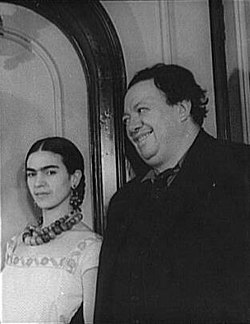Diego Rivera (December 8, 1886 – November 24, 1957), (full name Diego María de la Concepción Juan Nepomuceno Estanislao de la Rivera y Barrientos Acosta y Rodríguez) was a Mexican painter and muralist.

Diego is perhaps best known by the world public for painting a vast mural in the 1930s featuring early communist leaders juxtaposed with the Founding Fathers of the United States in the lobby of the Rockefeller Building. That work was quickly destroyed by angry Rockefeller staff people before it could be completed in that ___location; see the movie Cradle Will Rock for a reenactment.
Early career in Europe
On his arrival in Europe in 1907 Rivera initially went to study in Barcelona, Spain, and from there proceeded to Paris, France, to live and work with the great gathering of artists in Montparnasse, especially at La Ruche, where his friend Amedeo Modigliani painted his portrait in 1914. [1] The circle of close friends that included further Ilya Ehrenburg, Chaim Soutine, Modigliani's wife Jeanne Hébuterne, Max Jacob, gallery owner Leopold Zborowski, and Moise Kisling, was captured for posterity by Marie Vorobieff-Stebelska (Marevna) in her painting "Homage to Friends from Montparnasse" (1962). [2]
Paris in those years was witnessing the emergence of cubism in paintings by such eminent painters as Picasso, Braque and Cezanne. From 1913 to 1918 Rivera himself enthusiastically embraced this new school of art, as his masterly cubist paintings from this time demonstrate. His paintings began to attract attention; and was able to display them at several exhibitions.
Career in Mexico
In 1920 Rivera left France and, travelling via Italy, returned in 1921 to Mexico, where he continued his prolific career as an artist. Having been born in Guanajuato, he now became involved in the new Mexican mural movement. With such Mexican artists as José Clemente Orozco, David Alfaro Siqueiros, and Rufino Tamayo, and the French artist Jean Charlot, he began to experiment with fresco painting on large walls. Rivera soon developed his own style of large, simplified figures and bold colors. He had also become interested in left-wing politics. Thus when he painted his first mural, he presented ethnic Mexican subjects in a political context. Many of his murals deal symbolically with Mexican society and thought after the country's 1910 Revolution. His art, in a fashion similar to the stellae of the Maya tell stories. One mural “En el Arsenal” 'in the arsenal' [3] which shows to the left Vittorio Vidale, Tina Modotti (holding an ammunition belt), and Julio Antonio Mella (with hat) is said by some to elucidate the political murder of Mella. Rivera's radical political beliefs, his attacks on the church, and clergy, as well as his flirtations with trotskyites and left wing assassins made him a controversial figure even in communist circles. Some of Rivera's best murals are in the National Palace in Mexico City and at the National Agricultural School in ChapingoTexcoco.
Personal life
Rivera was a notorious ladies' man who had fathered at least two illegitimate children by two different women: Angeline Beloff gave birth to his only son Diego (1916-1918); Maria Vorobieff-Stebelska gave birth to a daughter in 1918. He married his first wife, Guadalupe Marín, in June 1922, with whom he had two daughters. He was still married when he met art student Frida Kahlo. They married on August 21, 1929; he was 42, she was 22. Their mutual infidelities and his violent temper led to divorce in 1939, but they re-married December 8, 1940 in San Francisco. After Kahlo's death, Rivera married Emma Hurtado, his agent since 1946, on July 29, 1955.
See also
External links
- Artcyclopedia - Links to Rivera's works
- Artchive - Biography and images of Rivera's works
- Short biography with photograph
- "Chronology & photographs" (year by year, animated)
- Detailed biography (with timeline and paintings)
- Biographical note with photographs
- Short illustrated biography (in Dutch)
- Biographical note (with self-portrait and photographs with Trotsky and Frida Kahlo)
- Self-portrait from 1941 and other paintings
- Marela Trejo Zacarías: "Visual Biography of Diego Rivera"
- Diego Rivera at the Detroit Institute of Arts
- Diego Rivera Mural Project
- Diego Rivera House Museum
- Virtual Diego Rivera Web Museum
- "Diego Rivera: Master Cubist" (12th painting in sequence: "Motherhood – Angelina and the Child Diego" (1916) depicting his common-law wife with their baby son.)
- Painting by Marie Vorobieff-Stebelska (Marevna) depicting on the very left herself, Diego Rivera and their daughter Marika, and on the right their mutual friends from Montparnasse, namely (top left to right:) Ilya Ehrenburg, Chaim Soutine, Amedeo Modigliani and his wife Jeanne Hébuterne, Max Jacob, the gallery owner Leopold Zborowski, and (bottom right corner:) Moise Kisling.
- The Life and Art of Frida Kahlo